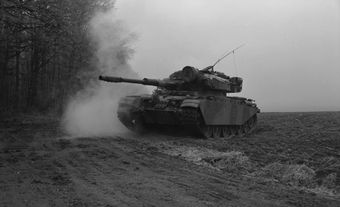West Germany introduced the Leopard 1 tank in 1965. It equipped several nations and went through six models (A1 to A6). Canada acquired its first Leopard 1 tanks in 1977 and operated them until 2017. (See also Armaments; Canadian Army.)

Development
Development of the Leopard began in 1956, with the first deliveries in 1965. The Leopard used the British 105 mm gun, along with a gunner’s coaxial machine gun and a crew commander’s external one. The Leopard had a multi-fuel engine, which could be replaced in under 20 minutes. The Leopard’s design emphasized speed, manoeuvrability, reliability and firepower over armour protection, which proved to be a successful combination.
Use and Variants
Germany built 4,744 Leopard 1 tanks. Besides Germany and Canada, 12 other countries fielded the Leopard 1. Canada and three other nations deployed Leopard 1 tanks on operations.
The Germans also produced 2,741 specialized vehicles. Three types of variants were used by Canada: the Taurus armoured recovery vehicle (ARV) repaired and recovered tanks; the Beaver armoured vehicle launched bridge (AVLB) deployed a 22-metre bridge; and the Badger armoured engineer vehicle (AEV) provided dozing, excavating and other capabilities.
Leopard 1 in Canadian Service
In the mid-1970s, Canada sought special trade status with the European Common Market. Canada’s European allies, especially West Germany, insisted on linking future trade negotiations with replacing Canada’s aging Centurion tanks. Canada quickly agreed to do so and selected the Leopard 1.
To allow time to manufacture new tanks, West Germany leased 35 Leopard 1A2 tanks to Canada. They served with The Royal Canadian Dragoons (RCD) in Lahr, West Germany, in 1977–78. In April 1977, the RCD won the Canadian Army Trophy — NATO’s tank gunnery competition — using rented Leopard tanks after only 16 weeks of training. (See also Canadian Army.)
Canada purchased 114 Leopard tanks, eight ARVs and six AVLBs for $187 million. The first Leopard 1A3 tanks arrived in the RCD in June 1978 and were designated Leopard C1 tanks by Canada. The Canadian modifications included the Belgian SABCA fire-control system with a laser rangefinder, Belgian machine guns, an American Zenon searchlight and a German low-light-level television for night engagements.
Three squadrons of tanks (59 vehicles in total) were based in Lahr, although only two were manned. The third squadron’s tanks were stored for reinforcements from Canada. The remaining tanks served at CFB Gagetown with a training squadron and the Royal Canadian Armoured Corps School. In 1990, Canada purchased eight AEVs.
In 1993, Canada withdrew its forces from Germany. A Leopard squadron went to each of the three Regular Force armoured regiments: the RCD, Lord Strathcona’s Horse (Royal Canadians) and the 12e Régiment blindé du Canada. In 1995, the Leopard tanks were upgraded with add-on armour. Canada deployed two Leopard tanks to Bosnia the following year and sent five to Kosovo in 1999. (See Canadian Peacekeepers in the Balkans.)
Leopard C2
In 1999, an upgrade of 66 C1s began. The Leopard C2 included an upgraded Leopard 1A5 cast turret, a new gunsight and an improved hydraulic system for a better cross-country ride.

In 2006, a 15-tank Leopard C2 squadron, along with four ARVs and four AEVs, was deployed to Afghanistan. (See Canada and the War in Afghanistan.) The C2 tanks received an additional armour package called MEXAS. They remained there until Canada concluded combat operations in 2011. During the deployment, the C2s were further upgraded with mine-resistant armour on the bottom of the hull, plus a crew cooling system and thermal covers to combat the heat in Afghanistan. In 2017, the Leopard C2 was retired and replaced with the Leopard 2.

 Share on Facebook
Share on Facebook Share on X
Share on X Share by Email
Share by Email Share on Google Classroom
Share on Google Classroom


